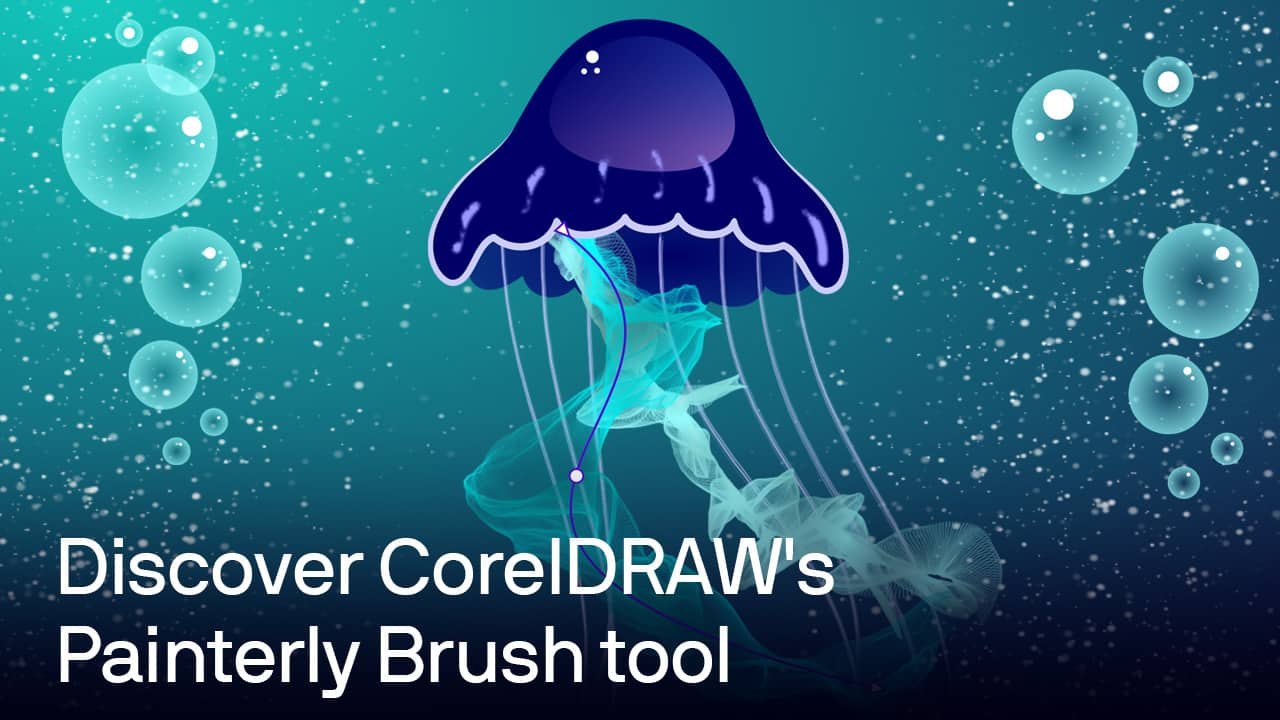How to use the Painterly Brush tool in CorelDRAW
To use the Painterly Brush tool in CorelDRAW, follow the steps below.
1. Activate the Painterly Brush tool
To activate the Painterly Brush tool, click the icon in the Artistic Media tool group on the left toolbar or press ‘J’ shortcut key.

2. Select a Painterly brush
Click the Brush picker dropdown list on the property bar to browse the various categories. The wide array of curated brushes includes textures of oils and acrylics, the graceful flow of watercolors, intricate detailing of airbrushing, dry mediums of pencils, pastels, chalks, and markers, as well as digital effects and physics-inspired particle brushes.
The categories can be expanded or collapsed by clicking the double arrows to the right of the category name. Hovering over each brush displays a stroke preview below the list.
Click a brush name to select it.

3. Adjust brush settings
The property bar also controls Brush size and Transparency and a Clear Brushstroke button which removes a brushstroke and returns the curve to a plain vector object.
In addition, you can toggle the Bounding box button on or off to show or hide the bounding box around brushstrokes.

4. Apply Painterly brushstrokes to objects
Painterly brush effects can be applied to existing paths, curves, and shapes created with various drawing tools.
There are two ways you can apply a brushstroke to an object or group of objects:
- Select the object or group with the Pick tool, then activate the Painterly Brush tool. Choose a brush in the Brush picker, and the brushstroke will be applied with the default size, color, and transparency for that brush.
- With nothing selected, activate the Painterly Brush tool, then click on the object or group to which you want to apply the brushstroke. Choose a brush in the Brush picker, and the brushstroke will be applied with the default size, color, and transparency for that brush.

5. Create new Painterly brushstrokes
You can also draw new brushstrokes from scratch. With nothing selected, activate the Painterly Brush tool and choose a brush from the Brush picker. You can adjust the size and transparency settings before or after you draw a brushstroke.
Click and drag to draw a brushstroke, releasing the mouse button to finish the stroke.
6. Change the color of Painterly brushstrokes
The color of the brushstroke is set according to the object’s outline color. To change the color:
- For Windows users, right-click a color swatch in the color palette.
- For Mac users, right-click on a swatch and choose Set Outline Color.

7. Create texture and background effects
You can also use the Painterly Brush tool to create texture or background effects.
Some brushes, like the Sprinkle brush in the Airbrushes category, will produce a spray rather than a defined stroke like a pencil or oil brush, making them ideal for creating background effects.
Experiment with increasing the brush size and drawing short strokes to create a textured appearance instead of defined strokes.

8. Modify and reshape Painterly brushstrokes
As with any vector object in CorelDRAW, you can use the Shape tool to modify Painterly brushstrokes.
Select the Shape tool on the left toolbar and then select a brushstroke; you’ll see small nodes along the length of the brushstroke.
You can add or delete nodes, move nodes, and use the control handles to adjust the path of the brushstroke. With each change, the brushstroke updates according to the new vector path.

9. Add Painterly effects to text
The Painterly Brush tool can also be used to add effects to artistic and paragraph text.
Activate the Painterly Brush tool and click on the text. Choose a brush in the Brush picker, and the brushstroke will be applied with the default size, color, and transparency for that brush.
Right-click a color swatch to change the color of the brushstroke and use the property bar settings to adjust the size and transparency.
If you edit the text or change text properties such as font, size, and other formatting options, the brushstroke updates accordingly.

10. Remove Painterly brushstrokes
Select the object or group with the Painterly Brush tool, then click the Clear Brushstroke button on the property bar.
Clearing a brushstroke removes not only the brush effect but also the outline properties of the object.
Once the outline properties are removed, the original object will be invisible if it has no fill properties. However, you can still find and select it in the Objects docker/inspector. To make it visible again, select it with the Pick tool and adjust the Outline width setting on the property bar.
11. Change default brush properties
To change default brush properties such as Brush size or Transparency, select the brush and change these settings on the property bar before you begin drawing.
To change the default brush color, click a blank area in the drawing window with the Painterly Brush tool to ensure nothing is selected, then right-click a color swatch on the color palette.
In the Change Document Defaults dialog box that pops up, make sure Graphic is checked and click OK.

12. Work with low resolution files
Because the Painterly Brush tool produces bitmap images, the document resolution will affect the amount of detail and image quality of the brushstrokes. Consider your intended output (print or digital display) and choose the appropriate document resolution before you begin.
13. Now you’re all set to start designing
Now that you know how to use the Painterly Brush tool, try it and see how it can be a game changer, whether adding simple strokes to your projects or bringing complex artistic concepts to life.
The versatile collection of Painterly brushes offers a drawing experience that encourages innovation and self-expression in every design pursuit.
Try Painterly brushes now
